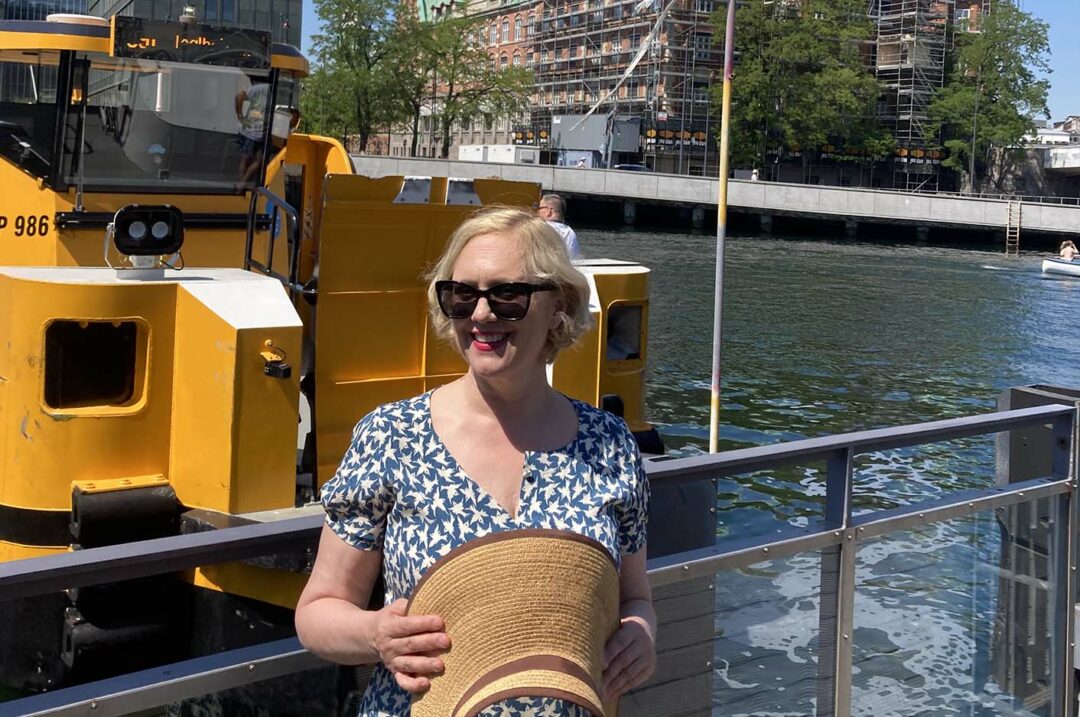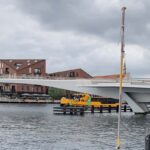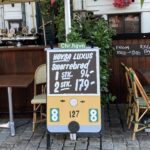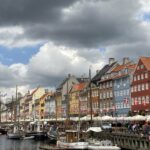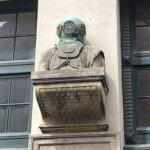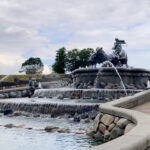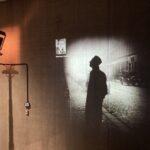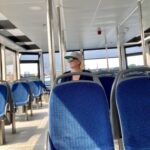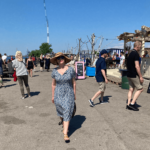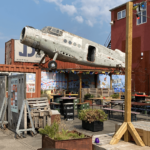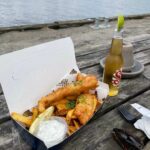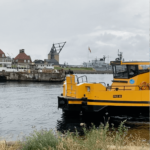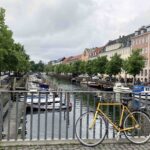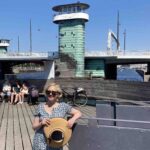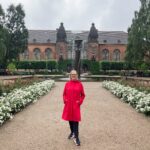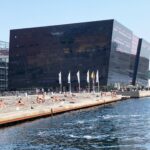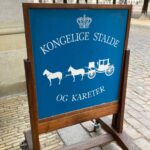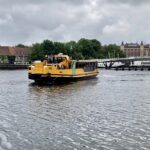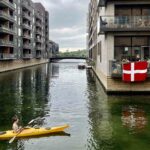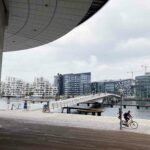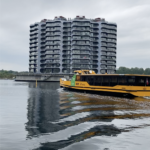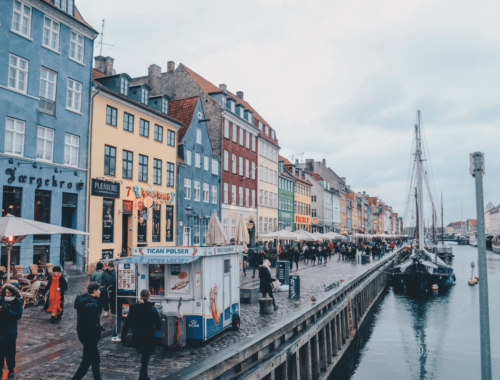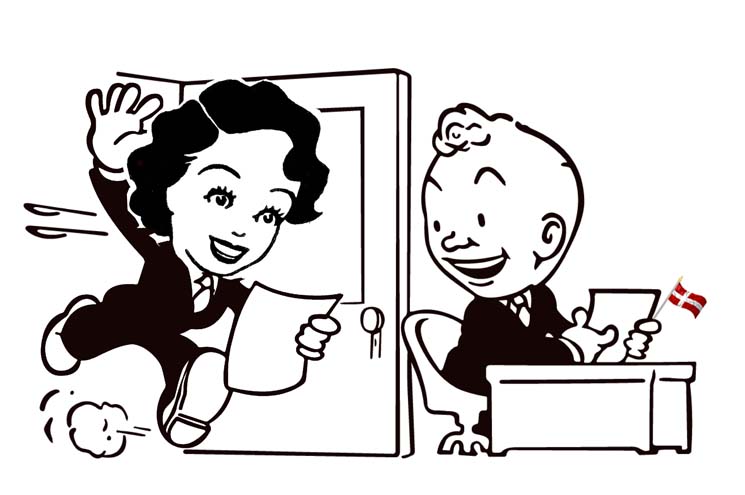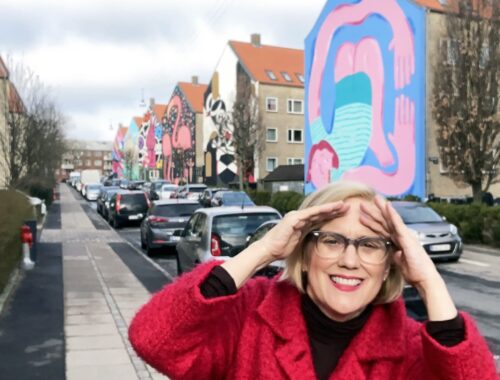One of Denmark’s cheapest and most colorful vacations is a few hours riding back and forth on Copenhagen’s big yellow harbor bus, or “Havnebussen”, a commuter ferry designed to transport ordinary citizens between downtown and the urban islands of Christianshavn and Amager.
For those of you who have no summer vacation plans yet, or who don’t have the cash to go very far, the harbor bus can take you from tourist trap to high culture to party culture, from shabby little wood shacks to neighborhoods of chic glass apartment houses with their own private beach.
All for as little as 14 kroner, or 2 euro, if you pay with Denmark’s popular rejsekort, or nothing, if you’re a tourist with a Copenhagen Card. (Beware – you cannot buy a ticket onboard, although you can pay with with the DOT Tickets app on your phone.)
You can start at any of the currently operational 7 Havnebussen stops, but let’s start at Nyhavn, in part because it’s the easiest stop to find if you don’t know Copenhagen well.
.
Harbor Bus Stop 1: Nyhavn
- The Harbor Bus approaches Nyhavn
- Dk94 for smørrebrød in the tourist traps
- The classic Nyhavn image, as seen on CNN
- Monument to scuba divers
.
Nyhavn is the long street of colorful old townhouses that’s usually shown in the background when an inexperienced news correspondent is “reporting from Copenhagen”. It’s one of the best-known views of the city.
This was once a kind of dangerous area full of sailors, prostitutes, and thieves, but these days the only thieves are the touristy restaurants here when they get their hands on visitors’ wallets.
Today I saw one of them advertising the open-faced “smørrebrød” sandwiches for the low-low price of 94 kroner apiece. My neighborhood restaurant sells them for 12 kroner apiece.
Walk past the curried herring to the Havnebussen
Anyway, to get the harbor bus, walk straight past all the overpriced curried herring and fried eel and the many variations on Carlsberg beer, walk past them right to the water, where you’ll see a circular pier. That’s the harbor bus stop.
One thing you should know about the harbor bus is that unlike most Copenhagen mass transit, it isn’t always particularly timely. It comes when it feels like coming, and it doesn’t feel like it until 1030am on weekends.
The men running it – and I’ve only seen men – all seem to be about sixty years old. They’re salty old sailors, and they’re not in a hurry. And you should also not be in a hurry, if you’re going to enjoy your trip.
So, bring some water, and spend your time waiting on the circular pier looking out at the sparkling harbor. Depending on the day, you’ll see swimmers, kayakers, rich kids waving from speedboats, and occasionally the Queen of Denmark’s yacht go by.
Get on Harbor Bus Route 992, towards Refshaleøen – the one that begins with an R – and we’ll head for the next stop, Nordre Toldbod.
.
Harbor Bus Stop 2: Nordre Toldbod
- The Gefion fountain near Langelinie
- From the Danish Resistance Museum. This guy was a Danish Nazi.
- The Harbor Bus sails past the Opera House, Copenhagen’s ugliest building
- Inside the harbor bus
.
On your way to the next stop on the Havnebussen, Nordre Toldbod, you will pass a Harbor Bus stop that is temporarily closed – Copenhagen’s Opera House.
Copenhagen is a beautiful city, but every pretty city has at least one ugly building, and in Copenhagen’s case, it’s the Opera House. Even its own architect wrote a book about how much he hated it.
The problem is that Denmark’s richest man at the time it was built, Mærsk Mc-Kinney Møller, was paying for the building and insisted on getting involved in the design. For example, he visited opera houses all over Europe to test out the seats, so the seats in his opera house would be the cushiest and comfortable ones.
He also insisted on having metal bars across the glass façade, making the whole thing look like some kind of giant bread toaster. In fact, the locals call it the toaster, because it looks like it has a piece of bread coming out the top. It’s a mess, at least on the outside. The inside is nice, though. Anyway, today we will just cruise by.
Tourist stuff and partying opportunities
We are going to Nordre Toldbod, an old customs area that is now a mix of great tourist stops and expensive partying opportunities. (Don’t worry, we’ll have cheaper partying opportunities at the next stop.)
The tourist stuff includes the Little Mermaid statue – which, remember, is very small – the English church, the lovely Gefion fountain, and the beautiful park surrounding the fort at Kastellet, which has a big windmill and a working outpost of the Danish army. You’ll see men in uniform here.
But for me, the most interesting thing to see is the new Museum of Danish Resistance.
This museum just opened last year – the old one burned down – and it is just the kind of museum I like. Small, so you can see it in an hour, and then have cake in the café.
It tells the story of the Danish experience during World War II and using multimedia and moving images it introduces you to four different actual Danes and lets you follow their experiences as the Nazi occupation develops.
Exposes Danish Nazi movement
For example, there’s a young engineering student. You meet him when the Nazis visit his school and make him angry, and then you meet him later when he joins the Resistance, and then later when he becomes a saboteur, and then you see the actual shirt he was wearing when the Nazis shot him. There’s a bullet hole at the back of the neck.
One of the things I like best about this museum is that it doesn’t hide the fact that at least 7000 Danes not only sympathized with the Nazis but joined them. In fact, one of the real Danes you “meet” is a Nazi. He goes to fight with the Germans on the Eastern Front, and then comes back to Copenhagen and becomes an assassin.
So, I can recommend this museum, which is entirely underground. Get it? It’s about the Danish underground, and the museum is underground. And I love the pricing structure – 95 kroner for an adult, but only 85 kroner if the adult is accompanied by a child.
Better selection of cheap food at the next stop
There are several little cafés and restaurants around Nordre Toldbod, but things tend to be expensive here because this is the headquarters of Maersk, Denmark’s largest company, and everything is priced for their well-paid employees.
If you don’t mind spending money, the Toldbod restaurant here has a great party scene right by the water.
For a better selection of cheap but tasty food, let’s get back on the Havnebussen and proceed to the next stop, Refshaleøen.
.
Harbor Bus Stop 3: Refshaleøen
- Kay at Reffen
- Refshaleøen has a great post-industrial feel.
- Fish and chips from the street market at Reffen
- The Harbor Bus approaches Refshaleøen
.
When the Harbor Bus pulls up to Refshaleøen, you might not be too impressed. “This looks like a meadow,” you may say.
And you would be right – the bus stop is in an empty area of this former industrial district. But you should get off the boat anyway, because there’s a lot of fun stuff to do here.
Back in the day, Refshaleøen was a boatyard. For more than a hundred years ships and ship propellors and ship motors were built here by thousands of workers.
From abandoned buildings to fancy restaurants
The shipyard closed in the 1990s, and when I first moved to Copenhagen I used to ride out here in the summer and look in all the broken windows of the abandoned buildings. It was very quiet, and the grass and the flowers grew wild.
Then, slowly, Refshaleøen started to become a recreational area, with indoor golf, climbing walls, an art museum, and fancy restaurants like Noma, once ranked as the world’s best restaurant.
Refshaleøen still has a really fun, funky post-industrial vibe.
Street food market
Anyway, my favorite part of Refshaleøen is Reffen, the street food market – dozens of booths with food from all over the world. Indian food, African food, hamburgers and hot dogs, Belgian food, food from the US state of Louisiana, ice cream, pizza, Moroccan food – whatever you want.
Plus alcohol: beer, wine, sangria. You can get whatever you like and relax on the sand listening to the DJ, or sit on beach chairs or at picnic tables overlooking the water.
This is a fabulous summer experience, and it’s suitable for everyone. Officially it opens at noon, I find a lot of the booths aren’t entirely open before 1 or 2. During the day, you’ll see a lot of families and older tourists, the 65-and-over travelers. Later, it becomes more of a party spot for young adults.
Anyway, to find the fun part of Refshaleøen, just follow the crowds and the music when you get off the Havnebussen. Or, if there are no crowds, just go along the water. You’ll cross a canal on a specially-made iron bridge, and all the good stuff is right on the other side.
.
Harbor Bus Stop 4: Knippelsbro
- Christianshavn canals
- Kay at Knippelsbro
- “Grandmother’s kiss” cake at Lagkaghuset
.
The next stop is Knippelsbro, or Knippels Bridge, named after Mr. Knip, who once sat in the control tower that opens and closes the bridge.
The current control towers – green copper towers in a cool art deco style – appear in numerous tourist images, including one of the images here. They were built on Refshaleøen, back in its industrial heyday.
Knippelsbro is the place you can get off the Harbor Bus and explore Christianshavn. It’s one of the loveliest parts of Copenhagen, with lots of 17th century houses and pretty canals. If you can’t fill up your Instagram here, you can’t fill it anywhere.
Alternately, you can also go for a more authentic local approach and visit the Eiffel Bar, one of Denmark’s working-class “brown bars.” The Eiffel has been serving drinks since 1736, and I don’t think they’ve updated their décor.
Famous bakery
Another good thing to visit on Christianshavn is the original home of Lagkagehuset, the most popular bakery chain in Denmark, which has now expanded to London and New York City under the name Ole&Steen.
Back in the day, when I lived on Christianshavn, there was only this one original Lagkagehuset. It was packed every day, and beyond packed on weekends. People would come from all around to get their bread there, and you’d sometimes wait an hour or so, holding a little paper number in your hand.
Interestingly, “Lagkagehuset” translates to “Layer Cake House”, which you would assume refers to the bakery’s product – cakes.
It doesn’t. It refers to the building in which first bakery is located, which supposedly looks like a layer cake. (Personally, I don’t see it, but whatever.) The building is the Layer Cake House, not the bakery.
Knippelsbro was one of my favorite stops on this trip, because we met a bride and groom celebrating their wedding on the Harbor Bus.
Dk14 per person? Now, that’s a way to save money for the honeymoon.
.
Harbor Bus Stop 5: Royal Library
- Kay in the Royal Library garden.
- The Black Diamond, with sunbathers
- Entrance to the Queen’s stables
- The Harbor Bus approaches the Royal Library
.
The Royal Library, or Black Diamond, is one of the city’s least friendly buildings. Not just because it has dark façade that reminds me of Darth Vader’s helmet, but because children are not permitted in the library. I understand the logic, this is a research library with unique and irreplaceable materials, but this does make it less friendly.
That said, if you’re doing the Harbor Bus tour and need to stop and use a bathroom, the Royal Library does have an extensive ground floor toilet option – 10 toilets x 2! And these are open to all.
Old Royal Library and its garden
This Royal Library was inaugurated in 1999, but the previous Royal Library still exists right across the street. I recommend that you go there and enjoy the old Royal Library Garden, which is one of the prettiest enclosed gardens in Denmark. It’s carefully tended, with old trees and huge banks of flowers. It’s very quiet and a very nice place to eat your lunch.
On the other side of the garden is Christiansborg, where the Danish Parliament is located. That’s a day tour in itself, but if you have limited time, I recommend checking out the Royal Stables at Christiansborg.
This is where the Queen keeps her horses – and they are very beautiful horses. Strong and healthy and well-maintained.
The stables are accessible to the public only at weird hours, and during the summer the horses go on a long vacation, just like all Danes.
Entrance is 60 kroner, but sometimes you can see the horses for free, outside getting some exercise or being harnessed to one of the Queen’s carriages for a trip around town.
Life of body vs life of mind
Back towards the Harbor Bus stop. In summer you can often see a lot of Danes sunbathing half-dressed by the water outside the Royal Library. Interesting contrast between the life of the mind vs the life of the body. And a little bit further south across the water, you’ll see the official swimming area at Island Brygge.
It’s one of Copenhagen’s great prides that this urban harbor is clean enough to swim in.
.
Harbor Bus Stops 6 and 7: Bryggebroen and Tegholmen
- Sluseholmen has canals instead of streets
- Flower shop at Teglholmen
- Bryggebroen looks like an architectural drawing
- James Bond Villain House?
.
The last two stops on our Harbor Boat trip are Bryggebroen and Teglholmen, studies in modern architecture. Here thousands of people live in neighborhoods that didn’t exist a decade ago.
The buildings look a bit like architectural drawings, with little model figures posed around to make the place look lively.
For people who live in the established Copenhagen neighborhoods, coming here can be shocking. It’s like visiting an entirely unknown city.
“Little Venice” with canals as streets
Sluseholmen is the older of these neighborhoods; the idea was to make it an updated version of Venice, with canals instead of streets. Apartment owners have the option of docking their boat outside their living rooms. It’s a pretty neighborhood, although probably chilly in the winter. (Venice is more than 1000 kilometers to the south.)
Nearby is Teglholmen, which is a newer neighborhood and rather upmarket. The ground floors of the buildings here are occupied by wine bars, balloon shops, and fancy flower vendors; nothing so boring as a dry cleaner or hardware store.
First new church in 30 years
Teglholmen will also be getting a new church, the first new church built in Copenhagen in 30 years. Danes are a lot less religious than they used to be, but confirmations and weddings are still big business.
These are not the most interesting stops for urban explorers, but useful Harbor Bus stops, because its purpose is largely to bring people from residential areas to other parts of the city.
Visiting Amager Meadow
Where to go next? To the south of Bryggebroen, and across the water from Teglholmen, is Amager Meadow.
This is a 23 hectares (about 300 football pitches) of mostly unspoiled marshland within Copenhagen city limits. It’s not a park, although there are plenty of walking trails.
As we say goodbye to the Harbor Bus, may I suggest that you walk across the pedestrian bridge at Teglholmen to the old Customs House – there’s sometimes a little coffee cart there – and beyond there, to the many wonders of Amager Meadow?
Thanks for traveling with me!
Follow the trip on:
.
.
.

